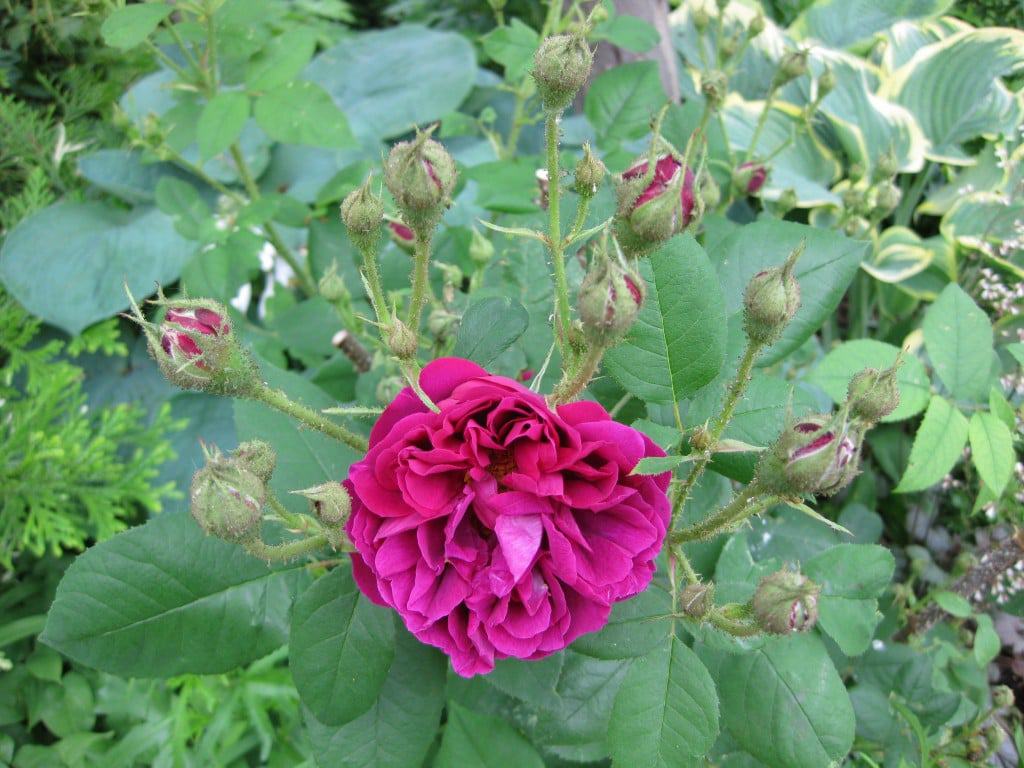
I walked out early this morning to find a thin layer of frost across the garden. This is the first frost of the season, and a clear sign that gardening time is growing short. The list of things to be done is long: planting tulip and hyacinth bulbs; cutting back some perennials (and leaving others for winter interest); digging out aggressively spreading weeds; and moving shrubs.
The onset of frost and lowering temperatures triggers the first phase of woody plant dormancy. As temperatures dip increasingly lower, woody plants are less likely to suffer shock when prised out of their comfy holes and carted across the garden to a new location. The colder the days become, the more deeply plants progress into phases of dormancy. I try to plan these moves for the first two weeks of November, when the soil in my Zone 6a garden is usually still soft enough to dig. There was one year when I was caught out by a hard and deep frost, freezing the ground before I could dig out shrubs or prepare their new holes. If that seems a possibility in lower zones, it’s a good idea to plan moves for late October. You can also save time and dig the new holes now, cover them with a piece of burlap or some conifer boughs, and save the excavated soil in your garage to keep it from freezing.
I have two plants that need new locations, and the first is my favourite shrub rose, ‘Etna’. Years ago I planted it at the edge of a bed beside the driveway. I can’t imagine a worse position for it, because the long canes reach out to snag everyone walking by. Frequently, I must cut the canes shorter than I’d like just to prevent injury to anyone trying to slip by the car. Why I couldn’t have foreseen these problems is a mystery, but the consensus in the household is that the rose must be moved.
There is no special technique for lifting a rose shrub, just the usual care to preserve as many roots as possible. First, I’ll cut the canes back, but only moderately to prevent losing or reducing the number of next year’s flowers. I like to use a blunt-nose spade to make a circle of thrusts all around the shrub (about 18 inches/45 cm out from the crown), and then gently lever it up. I try to hold the root ball together, and quickly shift it to a waiting wheelbarrow, covering it with a sheet of plastic to keep wind off the roots. I have the new hole ready and whatever soil amendments I need at hand (usually composted manure, leaves and pine needles). The rose goes into the hole, and the excavated soil is firmed around the root ball with pressure from hands (not feet). With roses, I set the bud union two to four inches (5 to 10 cm) below ground level. I provide a generous drink of water and pile 12 inches (30 cm) of leaves around the crown and over the root zone.
The second plant needing relocation is an upright Japanese maple (Acer japonicum ‘Aconitofolium’, syn. ‘Aconitifolium Maiku Jaku’, Zone 5). This flamboyant tree with fancy cutleaf foliage is sometimes referred to as dancing dragon Japanese maple. Recent removal of a large beech tree has left this little sapling in too much bright sun. It’s only 40 inches (1 m) tall and was planted last spring, so I don’t expect a large root system. I’ll move it in the same manner as the larger ‘Etna’ rose, and locate it in a part-shade location. With the Japanese maple, I’ll be sure to settle the plant’s crown at exactly the same level it had in the original site. I’ll also put a six-inch (15-cm) mulch of leaves over the roots, keeping it four inches (10 cm) away from the trunk so that no mulch is touching the tree’s bark.
These plants could be moved in spring, but weather conditions are more unpredictable then, which could prevent me from getting to the task early. The rose and the Japanese maple will settle in for a long winter’s sleep, and they’ll make new root growth far sooner than if I left their relocation to next spring.










Very helpful, and timely article. I really enjoy this website.
Great advice Judith. Re moving shrubs this fall. Should I move hydrangea plants that have never flowered in six years, or wait until spring ? Regards Diana..